Million Dollar Babies
With the recent sale in Las Vegas of the first confirmed Million Dollar Motorcycle (at auction), let's have a look at our list of other bikes that have sold for seven figures. Only one is confirmed, as auctions are generally the only verifiable sale, although of course trickery is always possible, and auction houses have been known to tout sales that didn't actually happen - as with the 'Captain America' chopper a few years back, and a Winchester motorcycle, each of which laid claim to the 'highest price ever paid at auction' in their PR, but both of which proved false on examination [see our 'Money Talks: the Rest Send Press Releases']. Private parties have claimed big sales, and newspapers have reported them too, so I've kept my list to motorcycle sales that seem legit, and some on this list I've verified personally with the buyers.
There are very likely other private sales of over $1Million, but I have yet to find details to support their inclusion; one of those rumors concerns a Honda RC166 six-cylinder GP racer, possibly sold to the Honda Museum for seven figures. There are others, with less credibility, but for the following I've been at least able to follow a trail, and ask a few questions.
Does a Million Dollar Baby mean anything to the motorcycle market, or the culture of motorcycling? No. But it's fun to watch from the sidelines, as let's face it, you and I were never going to own a 1915 Cyclone or an original-paint 1912 Henderson Four, so let the collectors have at it; a duel of credit cards at 20 paces! En garde!
1. 1915 Cyclone: $1.32 Million (Mecum Auctions January 2025, Las Vegas)

The auction action was thrilling: I was working Mecum's TV coverage of the sale, and we had anticipated a big price, but when bidding topped $1Million, I knew we were in for some entertainment. You can watch the sale on my Instagram channel, as I filmed my monitor screen during the action, with live TV commentary. You don't get to do that but once in a lifetime.
2. The 'Captain America' Chopper: ~$1.3Million (private sale, 2014)
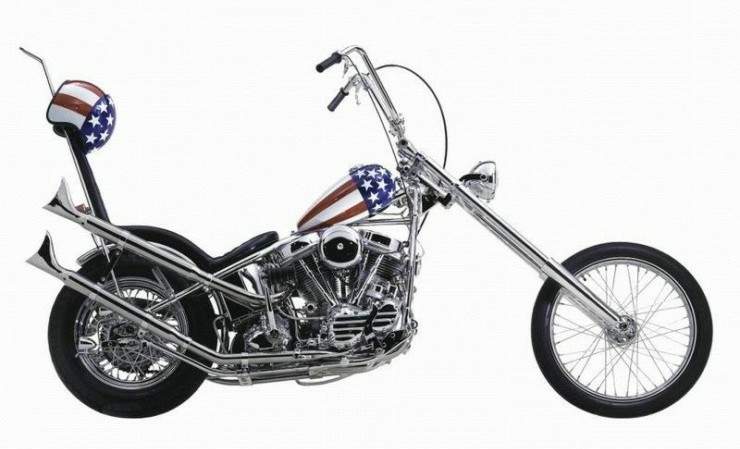
3. 1970 'Triple Crown Special' gold-plated Speedway Champion winner - $1,260,700
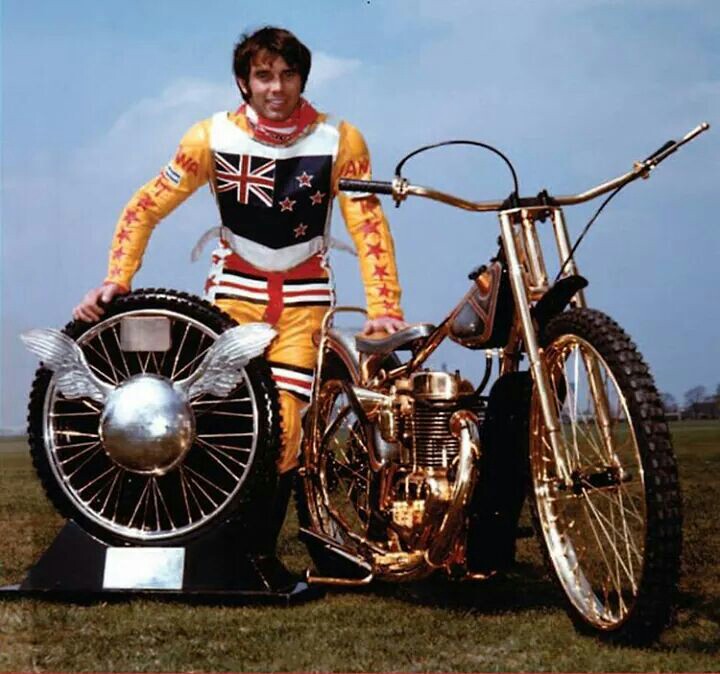
4. The 1947 'Bathing Suit' Vincent: ~$1.1Million (private sale, 2011)
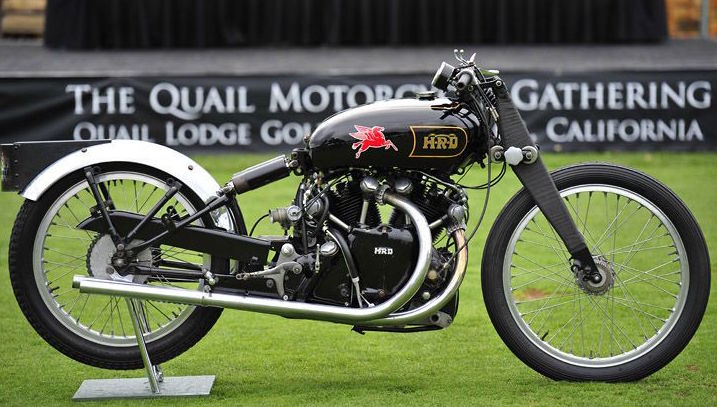
5 (tied). 1936 Crocker Big Twin Serial #1: ~$1Million (Private sale)

Al Crocker's V-twin was the fastest production motorcycle in the world in 1936, not that there was much production: it's estimated less than 75 were built between 1936-43. The Crocker predated the Harley-Davidson Knucklehead as the first OHV V-twin built for the street in the USA, and it was probably 20mph faster than a standard Knuck, especially if the customer ordered the full 100ci engine capacity available (they were usually 61ci - 1000cc). Al Crocker offered a money-back guarantee to any Crocker owner who was beaten by an Indian or Harley-Davidson, and there was never a need to make such a refund. Crockers have only grown in demand, with prices topping $600k in 2019. But Serial #1, the very first Crocker Big Twin, apparently sold to a California collector for a cool $1Million a few years back. I've heard the rumor from Those Who Know, and the purported owner could certainly afford that - he has quite a few Crockers in his warehouse! (Sorry - no photo available)
5 (tied): 1912 Henderson Four $ 1Million (Private sale)


Thunderbirds are Go!
The success of any group ride depends primarily on the character of its participants, and how they get along. By that measure, the Thunderbird Ride, organized by Jared Zaugg, was superb, bringing together an interesting mix of folks, from wealthy collectors / museum owners, to world famous artisans, to racers, to journalists and filmmakers, to folks who simply love bikes. Of course, #2 critical point for a good ride is Location, and the Thunderbird Ride had me at 'Moab Utah', the heart of everything magical in America's canyonlands. Third on the list would be the mix of bikes, and again, the Thunderbird scored on variety, combining world-class customs by Shinya Kimura and Max Schaaf, several vintage Triumph/BSAs/Moto Guzzi/Harley-Davidsons, a couple of newer/hotted up Harley-Davidsons reserved for long-traveled guests from Austria, and a pair of vintage choppers. The photos tell the story: this was a mix not found on any other ride, as rallies tend to be all antiques, or all choppers, or all new bikes, with rarely a mix of everything on wheels.





















The Legendary Nortons of Paul Adams
Anyone who ever lost a West Coast concours, anyone who raced AHRMA in the good old days, or vintage raced in New Zealand, or rode with the Velocette Club, knows the name Paul Adams. And if you’re really OG, you remember his front-page feature in Classic Bike back in 1986, with a devastating cover shot of the gleaming silver and black tank of a DOHC Daytona Norton Manx. That was one of Paul’s gorgeous restorations - which he happened to also race. How he came to restore that machine, and many other 'cammy' Norton International and Manx models, is a story in itself.



Paul Adams: “I'll start at the beginning. I owe a lot to my father, who was a millwright, and taught me about handwork and craftsmanship. That’s why I've never considered myself a collector; I considered myself a restorer. I had seen Nortons race when I was in junior high; my dad took us kids to the sports car races at various tracks around Southern California, and they often had a race for motorcycles. These shiny silver tank things with black and red stripes always seemed to win – they were Norton Manxes of course. So I had that in the back of my mind.”

Paul Adams: “I was a Navy guy, I’d enlisted when I was 17 and was in the reserves at Los Alamitos, in a P2V squad. Then I went to college for four years and got my degree in electrical engineering, then I went to work for North American and actually got to work on the Apollo program moon lander. But I owed the Navy three years of active duty as my reserve obligation, so I applied for flight training; now I owed them five years! I wasn't exactly smart when it came to managing that. I wound up flying A4 Skyhawks from the USS Kitty Hawk. My first cruise was 10 months in the western Pacific; the mission was to nuke Russia if necessary; this was 1963-64. Toward the end of that cruise Vietnam erupted, so we went down to operate off the coast in the South China Sea off Vietnam. Initially it was a big secret as we worked up in Laos, on the backside of North Vietnam. We lost a couple of guys there. When we were due for rotation after a 10-month cruise we came back home for about 6 months, then went back on my second cruise. That time it was all Vietnam; we did some flying in South Vietnam, but most of it was over the bad area. In North Vietnam we bombed big targets, so it was exciting, but we lost a bunch of guys, some were POW's, good friends of mine. When I got out of the Navy I flew for Continental Airlines. A perk was free flying passes, which came in handy later on as I became a regular traveler to vintage motorcycle swap meets, riding, and racing in England, New Zealand and Australia.”

“Then I found a 1962 Norton Model 50 that had been converted into a dirt bike, amazingly enough most of the bolts and everything on it were replaced with titanium! It was a real piece of work, and got me going on the Nortons. While I was restoring the Model 50, a friend of a friend from work, Jim Forrest, was introduced to me because he was a a similar soul, restoring an Ariel Red Hunter. We hit it off and he said ‘You gotta come on the Wednesday night rides.’ It turned out Jim’s dad was Howard Forrest, the guru behind Mustang motorcycles made in Burbank.

Paul Adams: “Yeah I was just getting to that! Jim Forrest worked there on the assembly line before he went to College, and one of the guys that worked there was Eddie Arnold. Ed organized a ride every Wednesday night out of his house up on Mount Washington and up the Angeles Crest Highway. Jim said, ‘it's really a lot of fun you gotta come along,’ so I did and got introduced to that world. Riding with us were Velocette riders John Munoz and Ron Thomas, so I fell in with a really bad lot! They got me going to the CAMA (California Antique Motorcycle Association) rallies every year, that Frank Conley put on. I got into the world of restoring; all these guys showed up with their restored bikes, and you could ride each other's bikes; we’d ride them around look at them and everything, in those days it was just enthusiasts, it wasn't a money thing at all. Everybody just did their own work and showed up at gatherings. That was my world, I fell in love with it. I'd been a model airplane junkie when I was a kid, and I wound up just doing restoration after restoration after restoration, because I was hooked on it and really enjoyed it. That started me off and I never looked back. Restoring bikes wasn't a money thing then, people didn't do it for money."



Paul Adams: “The bike I rode on all those Velocette rallies came from a neighbor, Don West in Palos Verdes. It had originally been sold by a San Diego dealer, and later acquired by Steve Tillett. He found it hard to start and traded it to Don for his BMW. Don brought it to a couple of the CAMA rallies but he was getting up in age – if he's still alive he'd be about 105. He sold it to me in the mid-1970s, so I’ve had it for 50 years. My friend Mick Felder, another neighbor on the coast of SoCal, invited me to a Velocette Club Spring Opener. That’s when I really had a purpose for the Velocette, so I started riding it all the time, on the 1000-mile Summer Rallies. I’d retired by then and could ride on the rallies I wanted, always on that Clubman.”

Paul Adams: “My Scrambler is unique, and documented as the only Thruxton-engined Scrambler ever built by Velocette. It was a special order from the factory by one of the ‘canal zone’ guys living in Panama, who all ordered British bikes direct from various factories to ride down there. Bill Hannah wound up with it, and he converted to look like a strandard Thruxton, so the only thing that was still looked like the Scrambler was the frame. That's the way I got it, but luckily Bill saved all the original Scrambler parts and it was all in great shape, so I converted right back to how it came from the factory. Then I used all the Thruxton bodywork and combined it with parts from Yashiko Thomas after Ron died. That used a Scrambler frame too. It looks like a brand new bike, but it's a bitsa.“
PDO: Since you've been at it so long, how do you see the collector motorcycle scene changing over the years?


Paul Adams: “I still have the bike John Munoz left me in his will, a rigid MSS with Swallow sidecar. I’m keeping my ‘Norton 4’ four-cylinder creation, and I can still ride that in my old age, it’s push button with electric start. I also have my Triumph pre-unit TR6C TT, I still ride that and just redid the engine. I was having problems with seizures, and I rebuilt it twice, finding things like worn out cams and stuff. I figured it was a timing problem that was causing it to seize, but the last time I took it apart I was blowing off the cylinder head and noticed bubbles coming up around the valve seats; turns out the head was cracked around both valve seats. I called Bill Getty, he goes all the way back to the early days, and he sorted me out with a new cylinder head, and it’s been no problems since, it runs great.”

Paul Adams: “One of the highlights of my career as a restorer and sometimes racer was in New Zealand. After Continental Airlines went bankrupt I returned to the the space world and went to work at Hughes Aircraft as a Flight Director of satellite launches. One day at work I got a call from a Ken McIntosh who wanted to talk about Nortons. It led to him inviting me down to go vintage racing at Pukekohe, near Auckland. I was a guest of Ken, we became good friends, and I kept going back for over 20 years! In the course of their events they always brought in noted racers as guests of honor and one of them was John Surtees. I met him at Ken's house on my first trip down there, and we hung around a little bit, and on my second trip down I arrived early and had to stay at a motel; John was there too, just the two of us, and we were eating breakfast and hit it off, not talking about bikes so much, and he offered to loan me one of his Manxes to ride at Goodwood Revival! That that was a highlight of my so-called racing career - to get an offer from a ride from Sir John Surtees. But all I could think of was ‘what if I dropped one of his bikes?’ I couldn't do it! I dropped my Nortons more than once, but that's racing.”
While John Surtees is a hero, there’s room for another in this story, and Paul has always been one of mine, ever since I read that 1986 Classic Bike article, which inspired me to start collecting bikes myself. Have a look at the remarkable Paul Adams Collection coming up for sale, it’s a corker, and if you want some really special, rare machines...call your bank manager.

Honeymoon on Mars, 1928
While it may sound like part of a wedding package circa 2050, after President-for-Life Musk develops his off-world colonies for space tourism, a lovely young German couple had the original Honeymoon on Mars nearly a Century ago. From a family album in a private collection (very near our lovebirds' home in Heilbronn), comes the anonymous tale that commences in 1925, with a proud young man on a Mars motorcycle. On this machine he toured, attended rallies with friends, even wooed and won his future bride, with whom he honeymooned after attaching a sidecar to his noble steed.




Our hero purchased his fabulous White Mars A20 in or before 1925, where he poses proudly in the woods near his home in Heilbronn, not far from the Mars factory in Nürnberg: it was the local product, one of many motorcycles manufactured in the region, but surely the finest in the era. He was an enthusiastic Mars man, and a member of the Mars Club, but he was no snob; he had friends who rode a D Rad, and even attended a D Rad rally with them in 1927. At a Mars Club rally in 1927, he proudly notes entering their road trial, where he rode 500km (300 miles!) without a single lost point, keeping his mount immaculate all the while.







As mentioned, the Mars was a unique and forward-thinking design built in Nurmburg, and was perhaps inspired by the proximity of airship and airplane construction in Friedrichshaven. The core of the design is the frame, a box-section tube made of bent sheet steel, riveted together. This incorporated the steering head and rear wheel support, as well as the fuel and oil tanks, and the twin-chain two-speed final drive. The result was an elegant design that looked far more modern than it was; the low power, two-speed drive, and lack of a front brake speak to the typical specifications of the day.






Reality Versus Fantasy: Thoughts on Scramblers
By Greg Shamieh
Bad Ideas always result in the most entertaining stories. Really Bad Ideas are even better. So here’s mine.
I have a BMW R75/5 motorcycle that I have owned and ridden for forty years. Just like animate beings, the Toaster has evolved over time, having been a naked bike, an '80s style sport tourer, and its current incarnation, a vintage style scrambler. On the gravel farm roads around my home, it’s as comfortable and capable as any motorcycle. Since I accidentally bought an adventure bike – I’m sure this has happened to you – I’ve been exploring adventure riding. My BMW F800GS Adventure has been both a lot of fun, and an occasional source of not fun, including trying to pound me in like a tent peg in my own garage – rupturing my right bicep tendon and requiring surgery to repair in the process. The event put me in the mind that perhaps smaller, lighter, shorter motorcycles might be better suited to my preferences for off-macadam operation.

“I realized that much of my favorite riding seems to happen under thirty miles an hour.”
As I listened to this, I experienced a great flash of illumination. The Adventure Motorcycle fantasy is Dakar-rally flash; large displacement, neon-colored offroad battlewagons blasting across the desert at high rates of speed, shooting roostertails of soil and sand, and taking big air off the dunes. The Adventure Riding reality, though, is guys like Nick, who are actually enjoying the environment through which they ride, and not so concerned about speed, style, other people’s expectations, or much of anything else. And the more I think about it, I think I come down on the reality side. What a surprise.




So what do we have when we’re done? My /5 has a torquey, low-end biased motor that has perfectly sorted carburation; my mods produced a motor that has punch in the lower part of the rev band. Want to break the rear end loose? Just flick that throttle open. Everywhere else, this is a sweet motor that provides easy, relaxed access to torque anywhere you’d like it to. The bike has a low standover height, a very low center of gravity, and that perfect sense of balance and composure on less-than-perfect riding surfaces that have kept generations of BMW boxer riders coming back for more. At a sustained cruise in the engine’s sweet spot at 3,800 rpm, the Toaster sounds exactly like a little airplane. I keep hoping and begging that BMW would make a ‘Heritage GS’ – a smaller boxer with lower overall mass and complexity than the new R1300s. Think something closer to the original R80, which had a sweetness and balance that the battlewagons just lack. Their beancounters tell them this is a funny idea. Oh well.


A Fickle Motorcycle Named 'Goat', 1909
Republished by permission of the California Historical Society and Gary F. Kurutz
“Roaring Around the San Francisco Bay Area on a Fickle Motorcycle Named “Goat” as Recorded in the 1909–1911 Manuscript Logbook of Walter Brooks”
by Gary F. Kurutz






A Revell-ation: Louis Lopez' Triumph
A craze for custom motorcycles were the hottest two-wheeled trend of the early 1960s, when the youth of America discovered the infinite coolness of custom vehicle culture. The writer Tom Wolfe did a superb job of discussing the scene in his essay 'There Goes (Varoom! Varoom!) That Kandy-Kolored (Thphhhhhh!) Tangerine-Flake Streamline Baby (Rahghhh!) Around the Bend(Brummmmmmmmmmmmmmm)…' published in Esquire in 1963 [read it here], which became the title of his first book (1965), 'The Kandy Kolored Tangerine Metalflake Baby', a pioneering example of New Journalism and a work of genius. Wolfe was not originally a custom car fan, just a journalist on assignment by the New York Herald Tribune sent to cover a show in New York City. He submitted his story, but knew it didn't do justice to the vibrant new scene, so approached Esquire with the idea of a long-form essay that truly captured the vibe of a 'Teen Fair' in LA. He references the rigid codes of teen fashion, language, and music, and interviewed George Barris and Ed Roth for their thoughts as the revered elders of a new subculture. It's a must-read.



"Spectacular indeed is Louie Lopez' '46 Triumph show bike, from its gold-chartreuse metalflake paint job to its quilted black leather seat with black fur trim. Features include metalflake cylinder head, sculptured tank, dual side-by-side front headlights, 21" front wheel and 19: rear, lucite footpegs, chrome oil tank with metalflake scallops and black striping."

"Bikes continue to capture the imagination and attention of auto enthusiasts and it was never more apparent than at the car shows, where cycles are appearing in ever increasing numbers. This custom ‘46 triumph was built by 23-year old Louis Lopez of Bell Calif., following up a chain of customized four wheelers that included a ‘59 Cad, ‘58 Impala, and a ‘57 Thunderbird which won three shows. Lopez spent six months and $1500 converting the rig and obviously succeeded and putting more ‘Umph’ in the Triumph. Gold hardware from the top tricks in the West include first places at the ‘63 Winternationals and at Larry Howard's show of custom bikes, as well as sweepstakes at the Trident sports arena spectacular. The lime metal flake beauty is chromed except for the rear fender, forward frame section and tank. Paint was applied by Junior’s House of Color, the tailored seat stitched by Martinez; Both of Lynnwood. Foot pegs, starter crank and foot shift lever are colored plastic. With assists from Gary Connor and George Foster, Lou developed a masterpiece that will go as well as it looks. The vertical twin engine is bored to displace 45 cubics, and has been fitted with 1 5/8” valves, alloy push rods and lightened rockers, a Jim Lemon Special cam and MC 12:1 pistons with Grant rings."






Desert Island Motorcycle Books
In 2022 I was asked by Jonathan Rishton - then-editor (now Publisher) of The Automobile magazine - for a list of eight 'desert island' motorcycle books, i.e., the books I'd take to end of the world. Choosing eight volumes for my desert island was easy; most were the earliest motorcycle books added to my collection, and remain at the heart of my career. The rest have entertained me for decades, with remarkable stories and photographs that spark the imagination. My work is principally online (for theVintagent.com), but it’s print my house is made of. Or at least that’s what you might think, should you pay an actual visit: our walls are actually covered with books. For your consideration, courtesy The Automobile (and if you'd like a physical copy of the Oct. 2022 issue, click here):

At the time of my selection (2022), this was the only book that had been made into a film: The Girl on a Motorcycle (1968). It stars Marianne Faithfull and Alain Delon, and follows the story of ‘Rebecca’ riding her Harley-Davidson across the Swiss border for a tryst with a former lover, with fatal consequences. Faithfull’s character is based, I am convinced, on Anke-Eve Goldmann, the German journalist and racing motorcyclist who invented the women’s one-piece leather riding suit – the original catwoman. She was friends with Mandiargues, and did not take kindly to being depicted as a sex object – the book is essentially softcore moto-porn. The film was the first in the USA to receive an X rating, but a version of Mandiargues’s novel La Marge (which won him the Prix Goncourt) was far more scandalous, and featured his personal collection of ‘pornographic objects’…

to sort her remarkable story; eventually I interviewed her daughter and ex-husband (who took the pictures). Approaches to Goldmann herself proved futile, and my offer to write her biography was firmly rebuffed. The book, the
film and the dissemination of her motorcycle photographs on leather fetish websites in the 2000s simply infuriated her. But perhaps she doth protest too much: those interviews left me convinced The Motorcycle was based more
closely on her life than she cared to have made public. But it was not she who was killed en route to a tryst… The Motorcycle is the one book I’d save above all others, if only to inspire the writing of a stack of increasingly bizarre erotic novels to be discovered with my body.

Danny Lyon was a photographer in the Civil Rights movement of the early 1960s, documenting voter registration
drives in the American South. He returned to his hometown in 1965 and joined the Chicago Outlaws, a one-per center motorcycle ‘patch club’. He interviewed club members and photographed their homes, bars, races, picnics and everyday life in a very early case of ‘embedded’ journalism. He published this work as The Bikeriders in 1968, to a thundering silence. Despite the success of Hunter S Thompson’s similarly themed Hell’s Angels, published one year before, nobody wanted a biker photobook with text direct from the subjects’ mouths.


In Swinging London of the 1960s, miniskirts were apparently more interesting than prewar motorcycle racing. Thus a significant pile of large-format glass negatives were found in the bin outside the offices of The Motor Cycle, no doubt part of a general clear-out of historical images lacking flares and sideburns. The fellow into whose hands these plates landed was Dr Joseph Bayley, who recognised many of the gents pictured as former rivals and comrades from his racing days at Brooklands. Bayley reckoned it had been 40-plus years since anyone had seen these pictures (now more than 100 years), and their high quality and natural appeal to racing folk would make a tidy book.

considered the Golden Age by the Grand Poobahs at the Vintage Motor Cycle Club. There have been several
such Ages in the intervening 54 years, but the 1920s does have a special charm: the simple machines, the gallant
racers in their neckties and scant safety equipment, the essentially amateur nature of motorcycle racing at the time. While Bayley mirrors a whole-page photograph with a simple reminiscence of the who, when and what, the pictures themselves speak volumes and the book is simply wonderful.

A son of privilege makes an impulsive boast at a fancy London dinner party; his bluff is called, and honour compels
him to make a two-year trip round the globe on a motorbike. That’s the elevator pitch for One Man Caravan, R E Fulton Jr’s account of his 1932-33 round-the-world adventure. It was Fulton’s luck that Kenton Redgrave, owner of
Douglas motorcycles, was at that soirée, and immediately offered to build a special machine for his journey, with an extra fuel tank and racks front and rear for luggage. Fulton packed it with pots and pans, his tuxedo, and a pistol
between the bash plate and crankcase, just in case. He never used any of it, ditching all but the pistol en route.
Fulton’s story is a beauty, plus he took a good camera, an excellent cine camera and miles of film. The book depicts a lost world with familiar names, and the journey made Fulton a philosopher. He forgot the pistol amidst his invariably friendly engagement with locals. His 1932 Douglas Mastif is currently in my ADV: Overland exhibit at the Petersen Museum in LA. I fished under the crankcase but the pistol is gone…

Ted Simon was a journalist in Fleet Street for 10 years before convincing the Sunday Times and Triumph
Motorcycles to sponsor a round-the-world (RTW) journey in 1973. Triumph thought it good advertising, but stopped production of Simon’s Tiger 100 model during his first year abroad. Regardless, he dubbed the bike Jupiter
and spent four years and 64,000 miles visiting 45 countries. He published Jupiter’s Travels in 1979 and it was an instant classic of global travel literature, inspiring countless imitators on two wheels. There’s a dividing line on RTW
travel: it’s estimated only 52 motorcyclists made an RTW journey before 1980, but après Ted, le déluge. This book and Fulton’s inspired my wanderlust, an interest in the history of overlanding, and ultimately my ADV: Overland exhibit. It’s a great read for anyone.

Vehicle ownership in the pioneer era was a DIY affair unless you had an engineer/mechanic on the staff. Manufacturers offered scant instruction and poor references for maintenance and repair: ‘refer questions to the manufacturer’. It took Victor Pagé to assemble a magnum opus of early motorcycling in 1914 that proved an
invaluable resource: Motorcycles, Side Cars and Cyclecars.

survey of bad ideas and wrong directions, plus undeveloped brilliance that would take generations to sort. Early editions with the fold- outs are rare, but the book has been recently reprinted and is still fun to leaf through,
especially for the cyclecars.

To American motorcycle collectors, the Golden Age of motorcycling happened before 1916. That’s
the year Harley-Davidsons got three-speed gearboxes, and ruined everything. ‘Pre-16’ motorcycle rallies were the heart and soul of the American scene, and Stephen Wright, while born in the UK, was an essential part of that scene as a collector of machines and ephemera, and a restorer of the rarest of racers: Cyclones, Flying Merkels, Harley-Davidson and Indian Eight-Valves. He converted his expertise and collection into three extraordinary books:
American Racer 1900-1940, American Racer 1940-1980, and The American Motorcycle 1896-1914. He’d planned a series of follow-up volumes, but death intervened, so we are left with just the three, and what beauties they are.

accounts cementing the historical record. If you can find one, dig deep: it’s a keeper.
The Bibliographer: The Art of the Motorcycle (1998), by Thomas Krens, Matthew Drutt (editor)
When BMW approached the Guggenheim Museum offering $3m to be title sponsor of an exhibition, director Thomas
Krens turned to his film curator. Ultan Guilfoyle was a dedicated vintagent, but didn’t consider himself qualified to curate a major motorcycle exhibit alone. He turned to Dr Charles Falco, a professor of optical physics who’d been
working with David Hockney on reverse-engineering the tools used by Renaissance painters to fix perspective on canvas.

the exhibition, and wrapped the interior of the Guggenheim’s giant spiral with chrome. Well, mylar, but it looked like chrome, and the show was a whopper, and remains its most popular ever. I had the good fortune of looking round
after-hours with the Brough Superior Club and nearly got myself locked on the rooftop, but that’s another story. The exquisite catalogue is the real story here, and, more importantly, the bibliography in the back: Charles Falco
assembled the most comprehensive English-language list of books about motorcycles ever published. I’m happy to admit I’ve collected all of the books in that bibliography, but now the list is 26 years old, and publishing didn’t stop, so 'the constant search’ continues.

Of Young Men and Motorcycles
By Geoff Drake
May your heart always be joyful and may your song always be sung. May you stay forever young. –Bob Dylan
In the early 1960s the hamlet of Carmel, California, was sanctuary to an assortment of Bohemian singers, artists, and writers who would soon leave an indelible mark on American culture. The famous folk singer Joan Baez had taken up residence in the Carmel Highlands, on a rocky outcropping overlooking the Pacific. There, she was joined by her lover, a precocious young singer by the name of Bob Dylan, whom she was busy promoting, leveraging her fame by inviting him to sing with her at her concerts. Joan's little sister Mimi, enchantingly beautiful at just 17, had recently rented a cabin with her new husband; singer, novelist and poet Richard Fariña.

It was a time of remarkable potential, with the folk music scene having become the voice an entire generation, expressing the disconnect between the values of a massive youth demographic and its 'best generation' parents, and the politics of the US government versus the ideals of its youth. It’s not hard to imagine Dylan, the Baez sisters, and Fariña plying the roads of Carmel and the Big Sur coast, prior to the current tourist inundation, while laying the groundwork for 50 years of folk music in America (an epoch chronicled in David Hajdu’s book, “Positively 4th Street”). In the spring of 1966, it seemed almost anything was possible. They could have no way of knowing what the next few months would bring.

Aura of Invincibility
In recent years Fariña had played music with Pete Seeger and Bob Dylan. He had toured and lived in Europe, and played and recited poetry in the creative cauldron of Greenwich Village, New York. He had married (after 18 days), and quickly divorced folk singer Carolyn Hester. Now, married to the lovely Mimi Baez, and armed with a penchant for self promotion, he found himself nestled among famous cultural iconoclasts of the day. But while he had been cavorting with the famous, Fariña struggled with his demons. Deep down, he was bitterly envious of Dylan’s soaring success on a world stage, and the ease with which he wrote songs—a great font of creativity that continues to this day. Moreover, Fariña had struggled for years to publish his novel, “Been Down So Long It Looks Like Up to Me,” a fantastical fiction that stylistically resembled the work of his college friend Thomas Pynchon, author of “Gravity’s Rainbow.”

After years of rewrites and petty squabbles with publishers, Fariña’s great project finally came to fruition in 1965, when Random House agreed to publish the work. With this news, and the undying support of his young wife, Fariña was positively flying. A book signing was organized to celebrate the great event, at the now-defunct Thunderbird Bookstore in the Barnyard Shopping Center, at the mouth of Carmel Valley. The date: April 30, 1966—his young wife’s 21st birthday. It’s easy to envision Fariña, then in his 20s, heady with the publication of his new book, and intimate with some of the world’s most famous and influential artists, conducting himself with the certain aura of invincibility that accompanies youth and accomplishment. The event started in the afternoon. There is a haunting image of Richard and Mimi Fariña, taken on a sunny deck outside the Thunderbird. She seems proud, yet strangely skeptical, as if his new trajectory in life couldn’t quite be possible, or if she was witnessing some implausible hubris. For his part, Fariña is looking skyward, slightly askance, as if he knew some strange visitation was in the offing. It was.

Zoom
After the intoxicating experience of the book signing, and with another one planned in San Francisco the next day, Fariña was primed for adventure. According to Hajdu, each book he signed at the Thunderbird had been accompanied by this simple inscription: Zoom. After the signing, he and Mimi both attended a party a few miles up Carmel Valley, in honor of his book and her birthday. A friend, Willie Hinds, then studying at Hopkins Marine Station in Pacific Grove, had arrived on a new, red Harley-Davidson Sportster. Fariña imagined that a fast ride on that beautiful road would be the perfect capstone to his day—a fitting harbinger of the great future that lay before him. One can only imagine the mental state of the driver of the new Harley-Davidson, Hinds, infected with the enthusiasm of his famous passenger and the power of what was then one of the fastest motorcycles on the road (if a bit ill-handling), on one of the best motorcycle roads in America.

Life at the Apex
I find myself fascinated by these events, perhaps because of the small ways in which my own life intersects with that of a man I have only read about. Like Fariña, I also know the Carmel Valley—I would even say intimately—from the seat of a motorcycle. Like Fariña, I have also written books—though not nearly as grand in scope—and I know the elation that comes with taking the first copy in hand, and the likelihood that one might feel just a little invincible, and prone to excess—vulnerable to the opiate of speed on two wheels.


Many have analyzed Fariña’s accident, looking for that exact patch of road just outside the village, on a series of left/right decreasing-radius turns, bordered by a low stone wall. It’s a place that has nearly caught me out on occasion. Was that the spot? Another account puts the accident site a few miles from the ocean, at a point called Steinbeck’s Pool. This section, with its long, sweeping curves in an open valley, looks to be nothing either spectacular or particularly challenging for a motorcyclist. However, when traveling at an estimated 90 mph, with a passenger fighting to keep the big bike upright, any curve is dangerous. Is the desire to understand the accident an obsession? A desire to avoid the same fate? Or a little of both? In any case, the story lingers in the mind, like a recurring dream. All motorcyclists know these thoughts. We ride these roads, we know the quality of the pavement, the turns, the braking points, and the gear required to accelerate cleanly out of each apex. When done right, it’s a thing of beauty, poetry. When done incorrectly, or in haste, it’s a mess, an abomination, a source of embarrassment. And maybe death.
Postcript
Richard Fariña is buried in the Monterey City Cemetery, which I view every morning over my right shoulder while riding to work. His small, flat stone is emblazoned with a peace sign. Judy Collins sang at his funeral. Mimi Fariña died of cancer in 2001. Her sister, Joan Baez, built a home on Miramonte Road, not far from the spot where her brother-in-law died. Richard and Mimi Fariña’s house on Mount Devon Road is still there: a low, flat structure that’s unspectacular in comparison to the multi-million dollar estates that now surround it. Regardless, it still commands a striking view of the rocky coast, and it’s easy to see how it would inspire the writing of any book, as it did for Fariña.

Dylan, the genius of his generation, seemed to have learned nothing from the tragic incident, if he was aware of it at all. In an ironic twist, just months later, he crashed his Triumph on a country road near Woodstock, New York. Afterward, he dropped from public view for years, though it has always been said that the accident merely served as an excuse to remove himself from the public eye, and that his injuries were not serious. Such things happen, sometimes at the absolute apex of your life. Or the moment becomes the apex of your life, simply because of what follows. Either way, you are remembered for it. And hopefully, for many other things, as with Richard Fariña.
[This article by was originally published in City Bike magazine.]

Coventry Motors Limited
While the name rings with Englishness, the charming worskhops of Coventry Motor Ltd can be found in the heart of Buenos Aires, Argentina, across the road from the Hipódromo San Isidro, where polo ponies and race horses more commonly ply their trade. In fact the Coventry workshops used to be stables serving the racetrack, which is obvious once you clock the series of identical large doors surrounding its central courtyard. "We kept the doors, but knocked down the walls between the stables," notes proprietor Fede Lozado, pointing out the numerous sub-businesses installed in the venue. A Zooz e-bike shop, a graphic design studio, storage for motorcycles, and most importantly, the combined workshop / display area that is the heart of the business.














My First Barn Find
Story and photos by Edward Kunath
In the summer of 1991, I had my first real job and real money. Pre-internet, I would regularly scour print ads for interesting old vehicles, gas pumps, etc. In the 90s, the word “picker” had not been invented. Chasing down antique vehicles as a hobby was not considered cool. One weekend a local swap sheet had a tiny ad that read '1957 Carmen [sic] Ghia': being a longtime VW fan, I literally ran out of the house, sped to the nearest cash machine and withdraw the maximum amount. The ad brought me to a house on the outskirts of town, and a soft-spoken grandmother answered the door: Mrs.H. was happy to show me the car out back. She was full of stories; Mr. and Mrs.H were the original homeowners in the area, back when it was 'country'. Over the years, as suburbia encroached, they sold off perimeter lots but kept the center lot for themselves. Down the hill, around a fence and all the way back, stood a corrugated tin shed, a barn, several antique tractors, and a few 30s & 40s trucks. Unlike a junkyard, all vehicles and equipment were organized into tidy rows, facing the same direction, and evenly spaced. My kind of guy.






"I went to high school with guys who, when they got all dressed up...slicked their hair up with some highly reflective oil product, and tended to wear suits of hard fabric with sharp creases, sometimes with a kind of greenish aurora-borealis luminescence about them...They enjoyed going through life with polished, shiny things, reflecting light on all those about them...
Others among us (I suppose I fell into this group) seemed drawn toward clothing, cars, and possessions that absorbed light to some extent, or at least contained a high contrast between glossy and obscure surfaces. Dressed for the dance, we showed up in slightly tweedy fabrics- usually in some color that seemed to be celebrating the annual peat harvest..."
Peter Egan, 'Wooden Boats', Road & Track, August 1991.

In the fall of 1998 we rode that old beast in matching vintage WWII 'Ike' jackets. To use a NZ expression, I thought I was the “cat's pajamas”. Not sure this was true, but this was the best life I could manage at the time. She married me, so maybe the Harley worked some magic.


It's embarrassing to admit that during my entire ownership, I've ridden the UL on its original 1950s tires. You can see from the original photos the distinctive balding pattern on the rear Firestone. By the 2000s, an older and far more prudent motorcycle friend had strongly encouraged me on more than one occasion, using words well known to sailors, to change the tires or stop riding it. From then on I rode it only for short distances and at low speeds. Sometimes I'd take it out for our local, weekly Harley block party. The owner is a keen motorcyclist and offered me two irresistible lures: a parking spot directly in front of the band to show it off and free beer.

● The hood ornament on the front fender, as best as I can determine, is from a 1949 Buick.
● The exhaust pipe is open, contains no baffling. My best guess is that Tom, the original owner,
made it.
● When I first purchased it, the butterfly valve at the end of the exhaust pipe was a mystery to me. My grandfather, born in 1914, knew immediately what it was. When closed, the engine warms up more quickly. In the past 33 years I have taken pains to make as few changes as possible. The photos from 1955 confirm the current condition. Here's what has changed:
● The tires were re-tubed.The oil tank and lines were removed for internal cleaning.
● A section of exhaust pipe on the rear cylinder had a hole. The exhaust covering was very carefully unwrapped. A new section of pipe was locally made in mild steel. The original covering was wound back into place. Repair is now invisible.
● Period Saddlebags have been added. The chrome bag mounting plates are original to the bike.
● The Linkert carb was removed and thoroughly cleaned in a commercial ultrasonic cleaner. A
Rubber Ducky float was installed along with a complete and correct carb rebuild kit from linkertcarbs.com. The ultrasonic cleaner, while effective, over-cleaned the carb exterior. Since then, the brass has gained patina and looks correct.

Mama Don't Take My Autochrome
Sorry for the earworm; I'm just passing it along, as I can't discuss the story of the world's first successful color photography without Paul Simon intruding on the soundtrack. Putting that aside for now, let's talk about the Lumiére brothers, August and Louis, who were deeply involved in the business of photography, and patented many processes and techniques that advanced the science of still and motion pictures. For example, they patented the film perforations used forever after on roll film and cinematic film, and patented a cine camera in 1895 that could record, develop, and project motion pictures.






The Autochrome process described:
Source potato starch grains measuring between 0,006-0,025mm: dye three batches, respectively in violet, green and orange, using water-based dyes. Mix the grains thoroughly. On a glass plate (0.9 - 1.8mm thick - 'single strength' glass), lay a thin gelatin or water-based varnish layer, and blow or dust the still-sticky layer with the dyes starch grains: blow or dust off the surplus grains. Add a layer of very fine lampblack (carbon) over the top, to fill in the gaps between the colored grains. Use pressure to ensure the resulting layer is only one grain thick. Apply clear varnish to seal and make waterproof. In a darkroom, add a layer of panchromatic emulsion. If you've made a large sheet of glass (the typical production method), cut plates to the desired size (eg, 4x5" et al). Store the plates in a light-tight container for future use in a plate camera.








The Vintagent Archive: 1973 Daytona Bike Week
Daytona Bike Week traces it roots to the 1937 origins of the Daytona 200 beach races, as a spontaneous gathering of racing fans who traveled to Florida to 'watch 'em howl...down in Daytona' [re: Vance in The Loveless]. As there was money to be made from vacationing bikers, the gathering was soon supported and organized by the Daytona Chamber of Commerce, despite a tradition of rowdy behavior and a legacy of as many as 20 rider deaths every year. Various associated events are organized around Bike Week, in Volusia County (the DeLand Bike Rally in Downtown DeLand on the first Saturday of Bike Week), and in DeLeon Springs. These days approximately 500,000 people make their way to Daytona for the 10-day event. Festivities include motorcycle racing, concerts, parties, and street festivals. The event is usually held on the first full week of March (including the Fri-Sat-Sun prior to) and contends with the Sturgis Motorcycle Rally as the most popular motorcycle rally in the United States.











First International Motorcycle Art Show: 1973
Art and motorcycles: today the words sit comfortably together, but in times past that pairing would be met with scoffs. While motorcycles have been explored as a subject matter for over a century, it took many decades for motorcycles to be considered a suitable medium for an artist with a respected career, or for 'motorcycle artists' to be taken seriously. It's still a struggle, and I've had many conversation with 'fine' artists who fear being pigeonholed if they dig too deeply into their love of bikes. And yet they carry on because they feel compelled, and not because it's a good career move. Some artists, like the Futurists in the 'Teens, respond to the energy and freedom of motorcycles - their kinetic potential and implications for mobility. Other artists are passionate about riding, with an inner compulsion to explore motorcycles as their subject matter (e.g. Billy Al Bengston, Conrad Leach, et al.). And some artists - collectively known as customizers - approach the motorcycle directly as their medium, modifying them to suit their vision, whether as art per se or as a functional sculpture (e.g. Ian Barry, Ron Finch, etc).





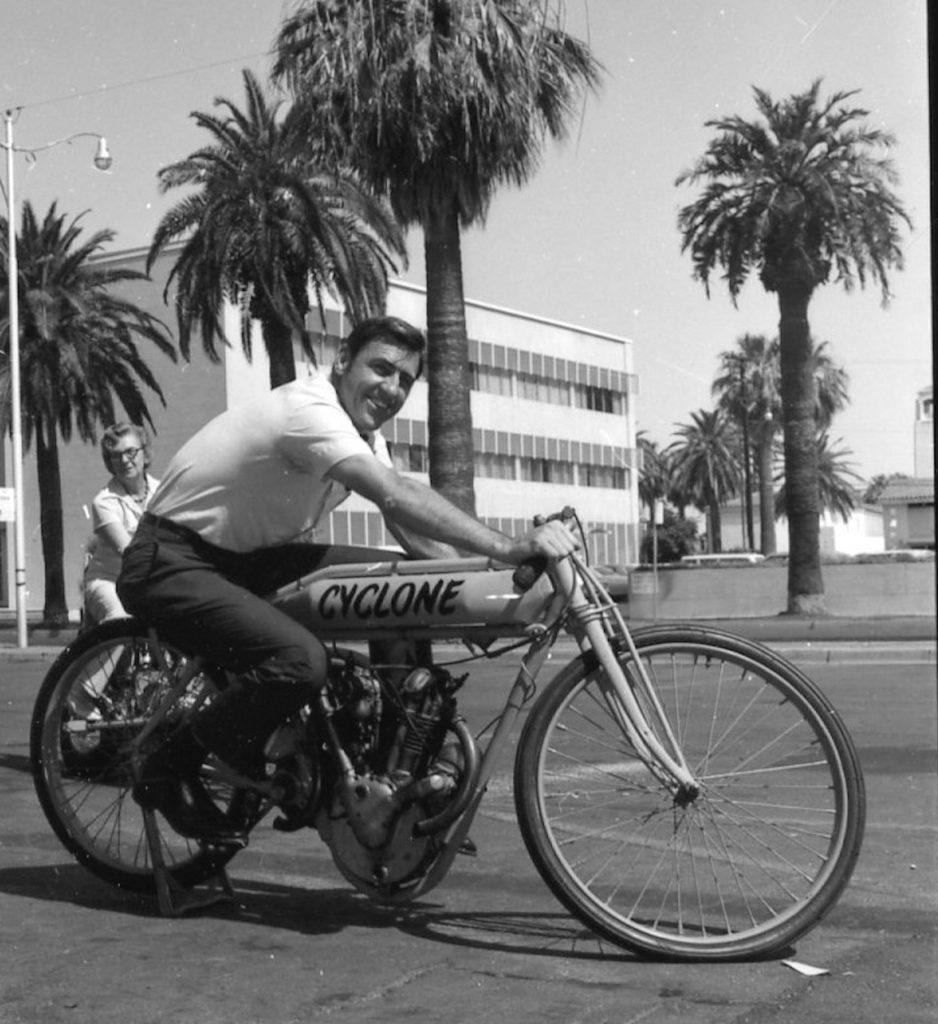
Clearly a man of vision, Mr Dorr had previously been an Assistant Curator at The Minneapolis Institute of Arts, a curator at the Amon Carter Museum of American Art, and was President of the Board of Trustees for the Shemer Art Center in Phoenix. 'GH', as he preferred to be called, came from a distinguished family line, as his grandfather Goldthwaite Higgison Dorr was a famous New York lawyer appointed to important Federal positions, and was something of a mentor to Richard Nixon at his law firm. If you're a fan of the Coen brothers movie The Ladykillers, Tom Hanks plays 'Professor' Goldthwaite Higginson Dorr, who is visually modeled after the original G H Dorr's famous goatee, which earned him a front page photo in Istanbul while an attaché in Turkey, as he 'looked like Mark Twain.' He's even captured in Richard Nixon's infamous 'White House Tapes' on August 18 1972, in which Nixon suggests G H spend his next birthday at the White House.


GH: As a boy in New York City and overseas just after WWII, motorcycles always caught my attention, and always ‘turned peoples heads.’ Years later, as Director of the Phoenix Art Museum in 1973, the motorcycle movie Easy Rider had become a cultural phenomenon inspiring freedom in style and motion. I thought it would be a novel and powerful idea to tap into that movement and bring that free-wheeling spirit of motorcycles-as-art to the people of Phoenix. And I believed it would further broaden the Phoenix Art Museum’s appeal to the wider community in Arizona and beyond.

GH: Especially so soon after some of the turmoil of the 1960s and early 1970s, the idea of bringing motorcycles in as art was viewed at the time as a bold experiment to say the least. It certainly pushed traditional boundaries beyond the usual art forms of paintings, photography, and sculpture. While the museum’s board of trustees approved the exhibit, some trustees were more receptive than others, and the ‘jury was still out.’ Nevertheless, I believed the exhibit would be a hit, bringing both art and motion to life.

GH: That was the secret sauce of this exhibit – sourcing the best motorcycles of all kinds, all vintages, all styles – and shipping them to the museum in time to prepare for the opening. Once we got the word out that we were putting on this exhibit, motorcycle collectors and aficionados came from all over, offering their bikes to participate in this pioneering event. When all was said and done – we had collected the finest and most diverse group of motorcycles ever. We had vintage Indians with bicycle seats, a Cyclone with bicycle tires, classic Enfields, WWII military side cars, BMWs, Harleys, and modern ‘Choppers’ of the 1970’s with their high handlebars, chrome, and customized artistic gas tanks. Those fashionable choppers of the time were popularized by movies like Easy Rider, so were right on trend for the times. One chopper even had a stunningly painted gas tank by the famous 1960s/1970s artist Peter Max.

GH: With all this horsepower in the museum, it was an absolute hit! Current members and patrons were joined by many new visitors, as young and old came from near and far to experience this unique gathering of motorcycles as art. It was thrilling to see so many coming to the Phoenix Art Museum and enjoying this event. The exhibit stretched the bounds of interaction with art, engagement with art. Looking back, it was amusing that the interest was so high that we even had to add signs and continuous security asking people not to touch or sit on the bikes!

GH: In the end this exhibit was a truly unique, pioneering experiment -- ahead of its time in bringing exciting art to people and more people to art. Twenty five years later in 1998, it was exciting and gratifying to see that the Guggenheim Museum in New York held a similar and very popular “The Art of the Motorcycle” exhibit. We also had fun in the 1970s bringing the “Space Art Exhibit” to the Phoenix Art Museum and community (moonrocks, astronauts, and Bob and Louise McCall)!










Summer Time is Rally Time
Summer Rally: when nerds gather to point out the many ways your bike is wrong. Right? Nah, not all of them. The 2024 Velocette Owner's Club summer rally was my 33rd week-long, 1000-mile event with the club. As you might have guessed, I've owned a lot of motorcycles over the past 45 years, so what brings me back to this event rather than others?


































Artist and His Moto Guzzis - Antonio Ligabue
Solace. The word is seldom associated with the allure of motorcycling, but all of us have felt it. The old cliché 'you never see a motorcycle parked outside a psychiatrist's office' has a core of truth: while riding a bike can be thrilling, there's a peaceful flip side to the experience. Most riders see-saw between both poles: the excitement of power at your wrist, and the calm of moving through a landscape, alone with your thoughts. Both these inner states are addictive, and are probably equally responsible for riders' devotion to their wheels. There's little written on the subject, perhaps because sex sells, and motorcycles' sexy side gets the headlines.



There were no special facilities for 'different' individuals from poor families in the early 1900s, and Antonio was repeatedly moved from various schools due to his disruptive outbursts. In 1913 he was handed off to a Swiss couple, Johannes Valentin Göbel and Elise Hanselmann, who were also childless and poor itinerant laborers. Antonio's health continued to deteriorate from malnourishment, and his mental health from an abusive adoptive father, and unhealthy relationship with his adoptive mother. His last school was led by evangelical priest in Marbach, but he was expelled in 1915 because he habitually blasphemed and was caught numerous times masturbating. He did learn to read, but found his greatest solace in drawing, at which he showed astonishing facility even as a child. In 1917 he experienced a violent nervous breakdown, and was hospitalized for three months.








The Magnolia Four - a 100 Year Motorcycle
Motorcycle designer JT Nesbitt, lately of Curtiss Motorcycles, is branching out into new-old territory with his latest design. As a fan of the design of vintage motorcycles, and a vintage bike owner/rider, he's long pondered how one could make a successfully modern motorcycle that pushed the right emotional and aesthetic buttons for enthusiasts of vintage machines. He's been talking about this for years in fact, sharing sketches and ideas with his peers, honing in on what might work in practice, with intention of limited production. As an homage to his New Orleans roots, he dubbed the project the Magnolia 4.
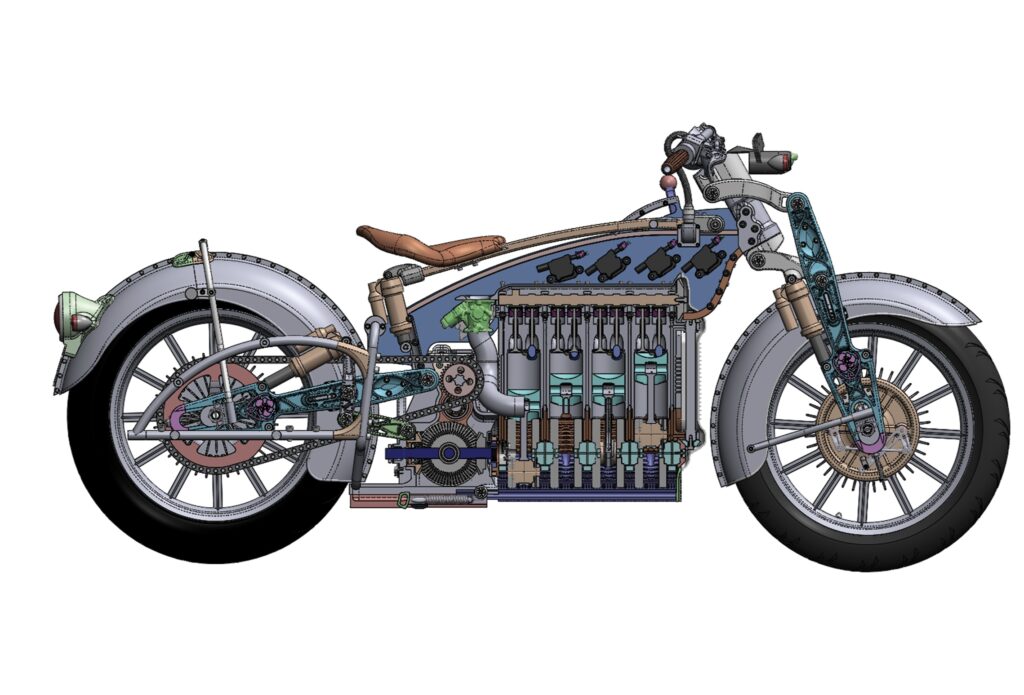
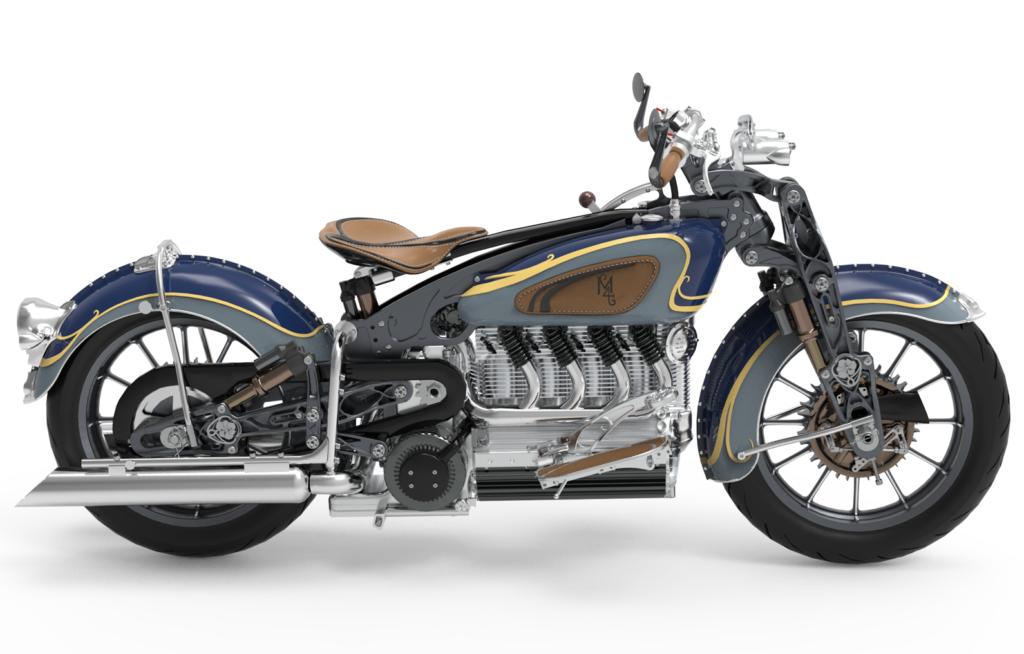
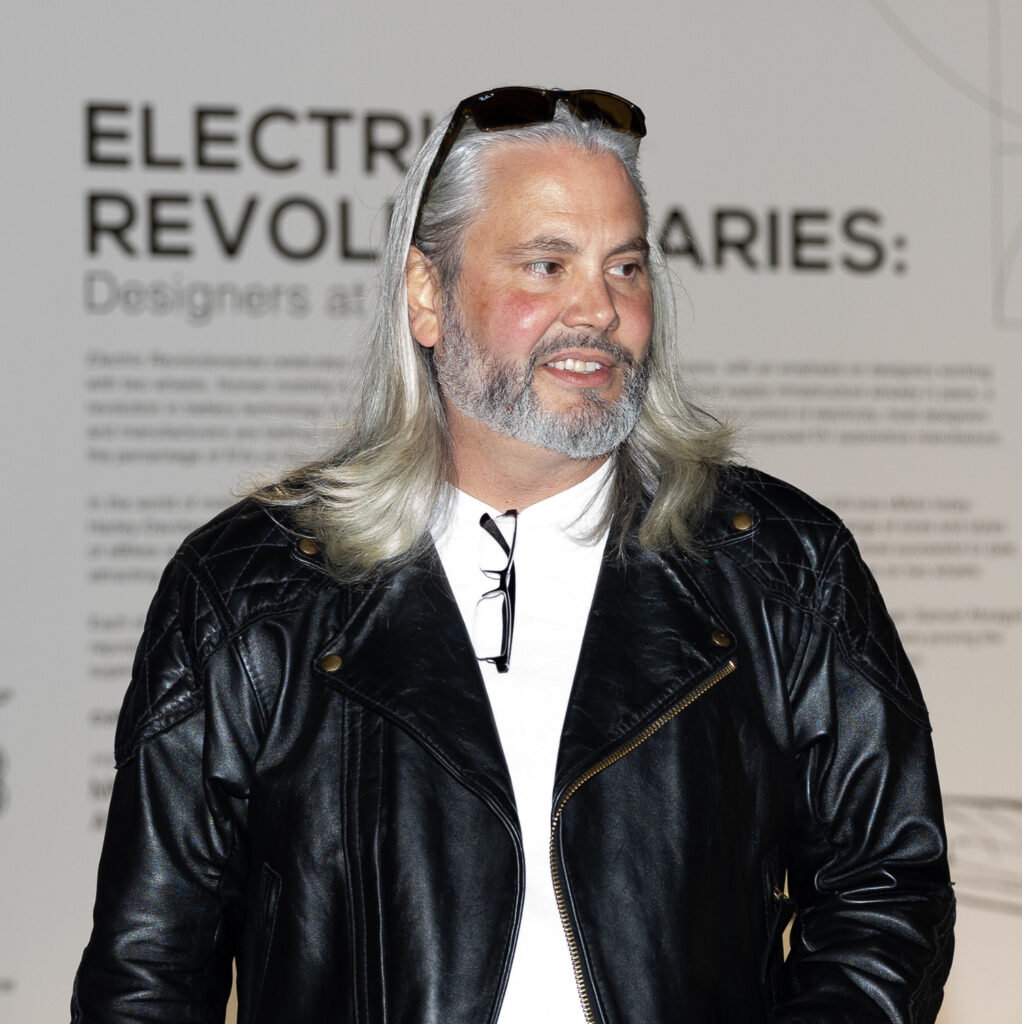
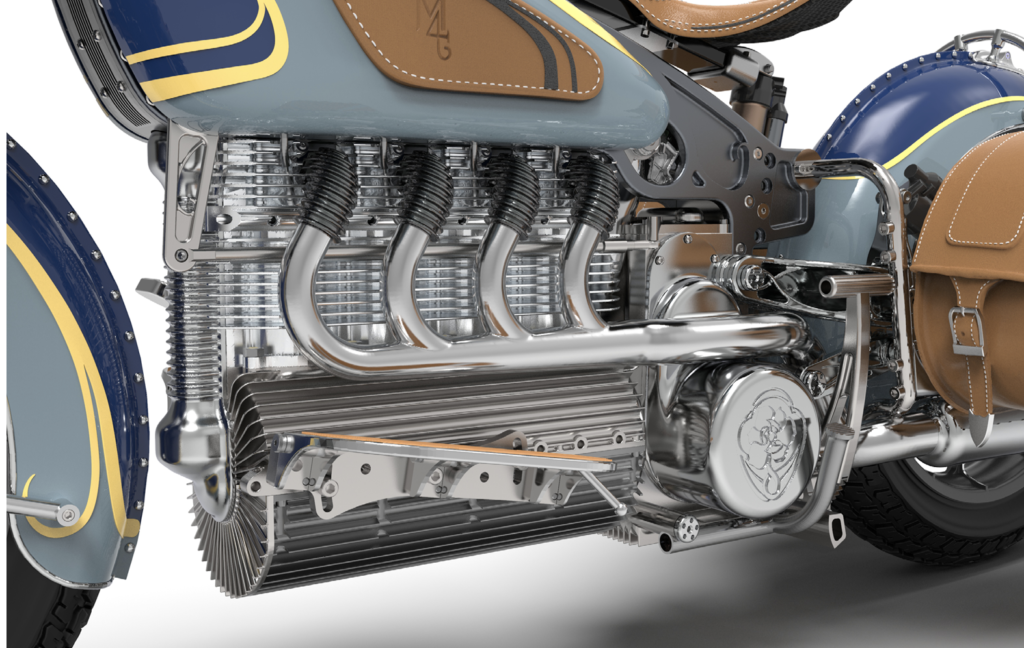
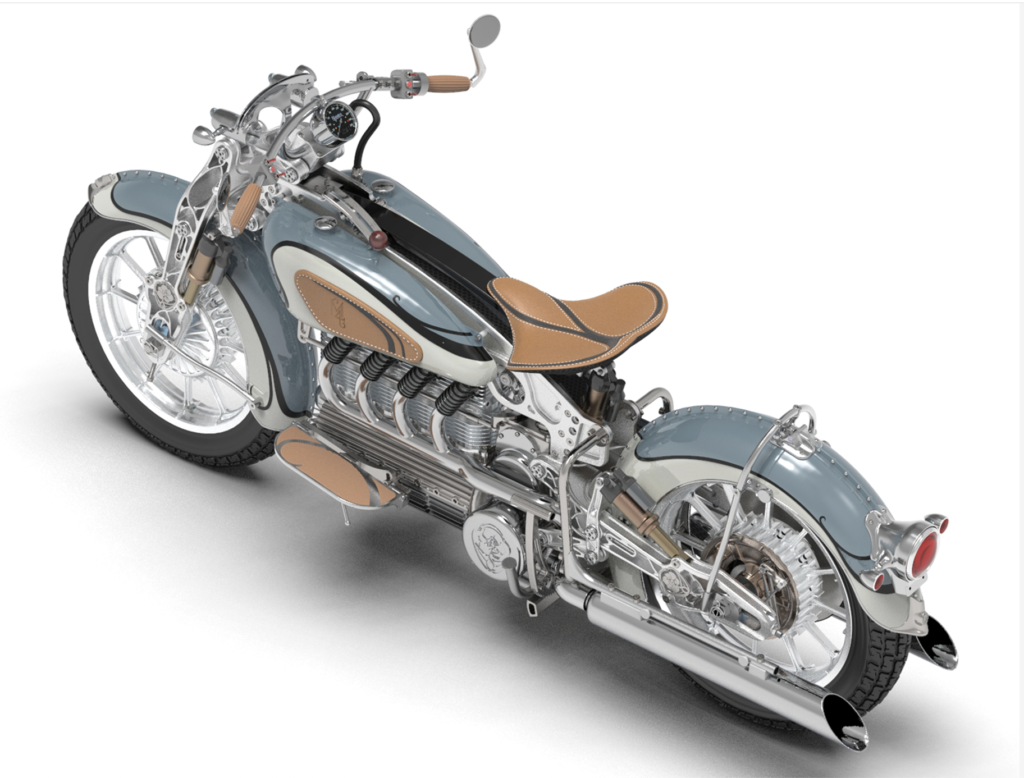
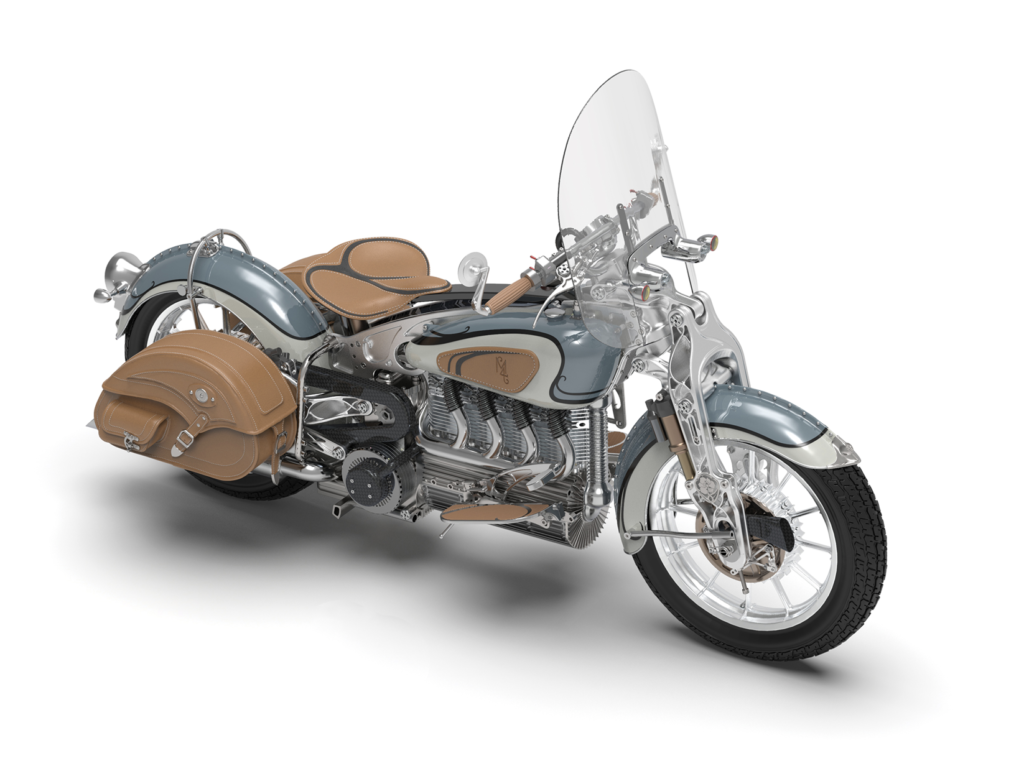
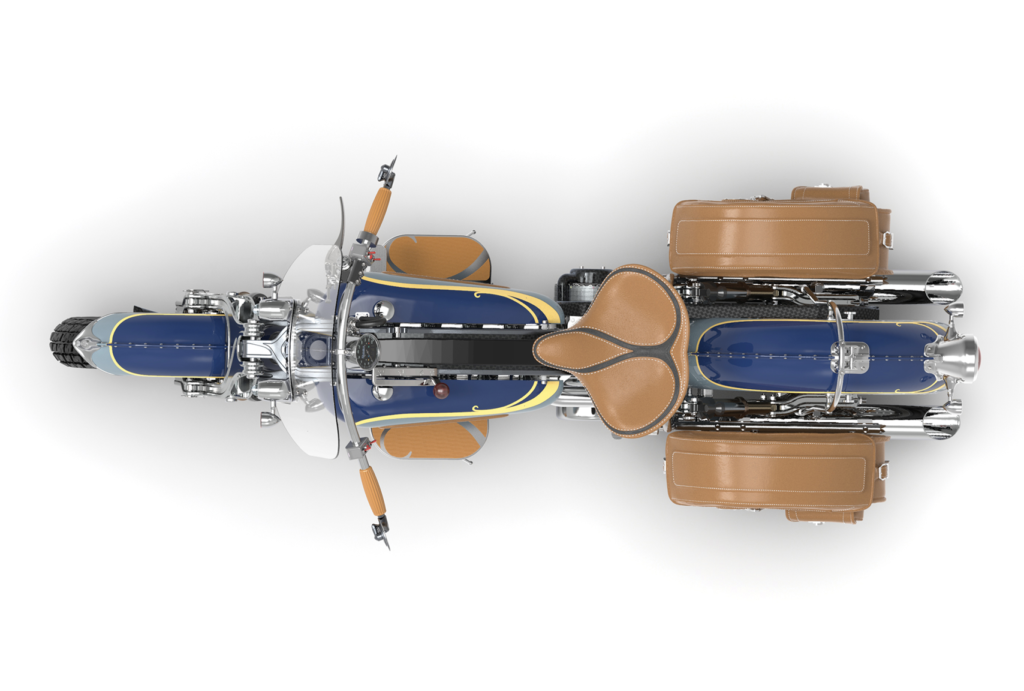
[UPDATE: in the first hours after posting this article, JT pre-sold TWO Magnolia 4s. No I don't get a commission ;) But he wanted to stress that his intention was to produce a dozen Magnolia 4s, and as one is for him, that means there are 9 spots left. Given the interest already demonstrated among Vintagent readers, I'd say if you're interested, better give JT a shout. ]

First Handbuilt Invitational LA 2024
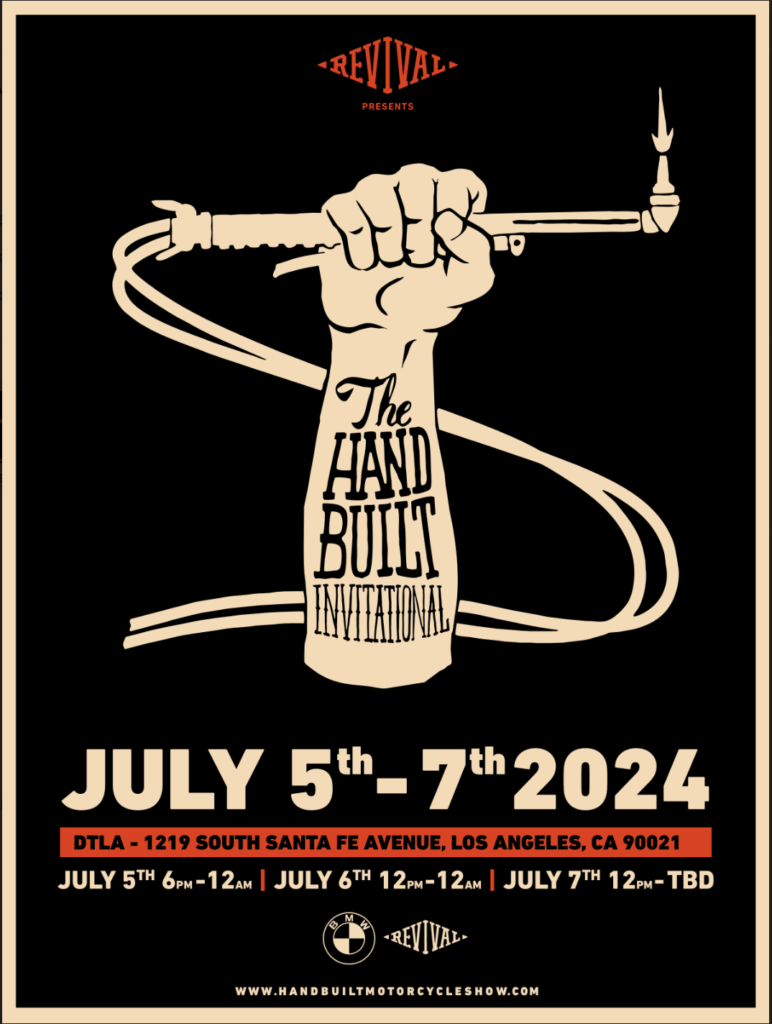
Just in time for the 10th anniversary of Revival Cycles' Handbuilt Show in Austin, the esteemed brand of Alan Stulberg is branching out to Los Angles for the first Handbuilt Invitational. The Handbuilt ethos is the same, to display "machines built by amateurs and professionals" with the aim of inspiring people "to work with their hands, and try and improve or repair every physical thing they own and interact with." That's a lofty ideal for a motorcycle show...but this new iteration of the Handbuilt vibe has grown to include cars, with invited builder/collectors including heavy hitters like Icon 4x4, the Philip Sarofim collection, Jay Leno's Garage, the Petersen Automotive Museum, ArtCenter College of Design, and Race Service. That's in addition to the usual two-wheel suspects like Shinya Kimura ('most Shinya builds in one room ever') Roland Sands Design, Christian Sosa Metalworks, and Bryan Fuller Moto. It's an experimental mix, and should prove popular, as the social media power of the included businesses is in the mega-millions.
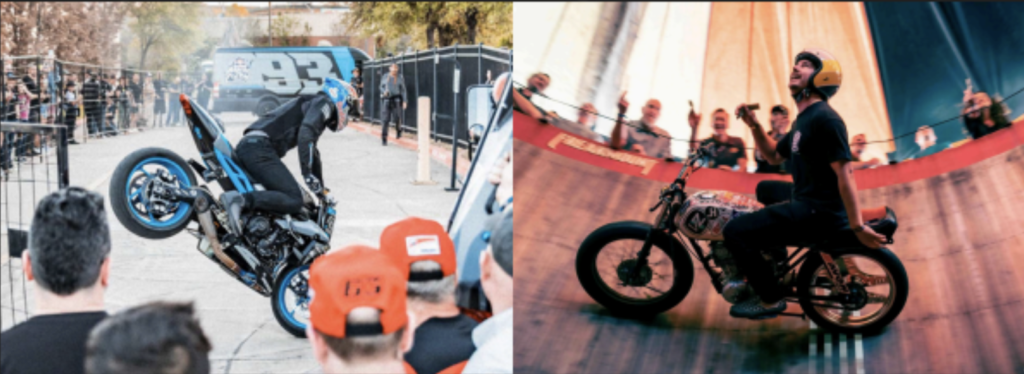
The expanded focus for LA includes a 'female forward' area that includes Stellar Brand, RealDeal Workshoppe, and invited womyn builders. Mobile entertainment will be provided by Red Bull stunt rider Aaron Colton, the ever-popular Ives Brothers Wall of Death, and Saturday night live music by The Lion Heart. Our Cannonball buddy Craig Jackman (American Electric Tattoo Co.) will be laying ink on skin, if you're so inspired.
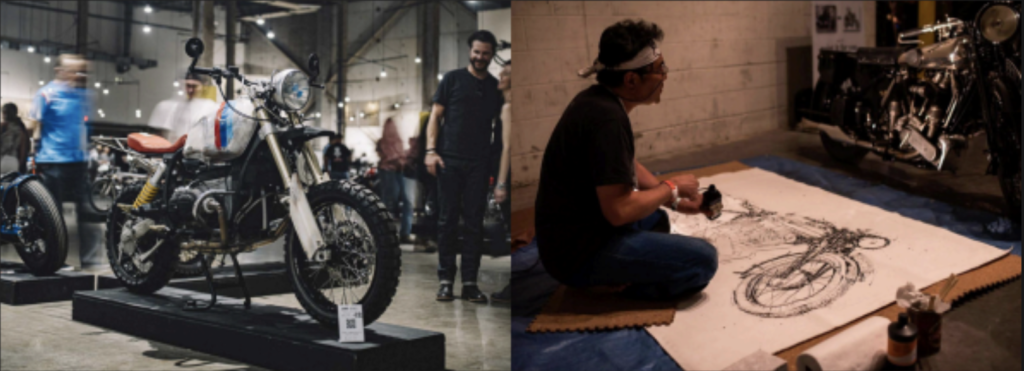
Where and When:
DTLA Auto Storage: 1219 S. Santa Fe Ave, LA 90021
Friday July 6: 6pm-12am (press opening 12-4pm)
Saturday July 7: 12pm-12am
Sunday July 8: 12pm-6pm


















